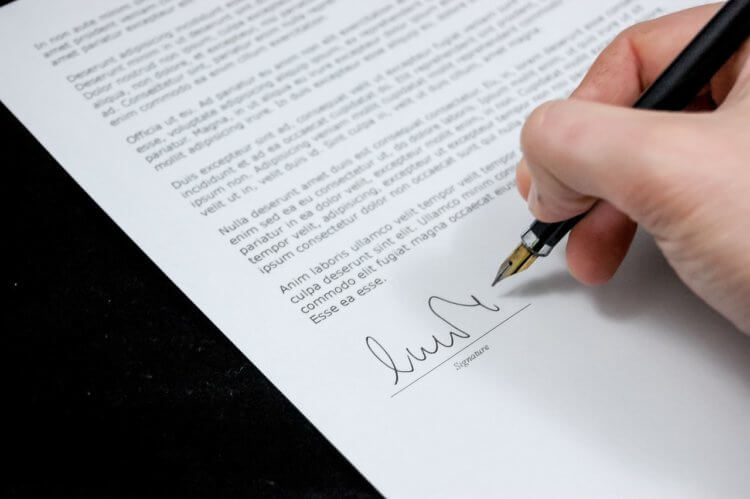New business is key to your law firm’s growth, but that doesn’t mean that every prospective client is a good fit for you and your firm. If you consult with prospective clients but don’t move forward with representing them, you should close the loop with a non-engagement letter. This ensures all parties are on the same page.
A non-engagement letter may feel like a formality, but notifying a potential client—in writing—that you won’t be representing them is important. Letting them know explicitly that you will not represent them will help you avoid or successfully defend malpractice claims. Also, clear client communication is essential for your law firm to provide a client-centered experience to everyone you interact with as an attorney. This includes those who don’t ultimately become your firm’s clients.
In the following guide, we’ll review the fundamentals of non-engagement letters, and go over why you need them. We’ll also provide a sample non-engagement letter that you can refer to as an example when creating your letter. Let’s begin by considering a few key questions about non-engagement letters.
What is a non-engagement letter?
A non-engagement letter informs prospective clients that the attorney will not be representing them. Lawyers prepare this type of correspondence to clarify and document the status of the relationship. This is done after consulting with a potential client—formally or informally—and deciding that they will not or cannot represent them.
Why do you need a non-engagement letter?
There are many valid reasons why you or your firm may choose not to take on a specific client. Sometimes, a client may decide to not move forward with using your legal services. You may need a non-engagement letter due to a conflict of interest, a lack of capacity at your firm, or the client’s inability to take on your fees. You could also just not be the right fit. When one of these instances arises and you won’t be representing someone that you discussed a matter with, you need to formalize that decline with a non-engagement letter. Here are three reasons why:
1. To avoid malpractice claims
Unintentional miscommunication about representation is a common cause of malpractice claims against attorneys.
When a prospective client has a conversation with a lawyer (whether it’s formal or informal), they may think that the discussion in itself means the lawyer will represent them. If the attorney does not formally notify the client they will not be representing them, the client may assume that they are taking care of their legal matter—when they’re not.
The prospective client could then miss a statute of limitations or get an otherwise unsatisfactory legal result, for which they could blame and sue the attorney.
A non-engagement letter removes that ambiguity in a similar situation. It makes it clear that you will not be representing the client. This way, there is no confusion for the prospective client. This also helps you avoid the potential subsequent malpractice claims. Should the prospective client then try to sue an attorney, a copy of the non-engagement letter can be useful in helping to resolve the conflict.
How non-engagement letters help you avoid potential malpractice claims
For example, let’s say an attorney has a discussion with a prospective client about a time-sensitive transaction. The client shows the lawyer a copy of their documents during a consultation. The lawyer looks at the documents and decides they will not take on the client. However, the attorney does not send a formal non-engagement letter. The attorney assumes that the client will find another lawyer when they don’t follow up, but the client assumes that the lawyer’s silence means they are handling the case. Nothing gets done, and the client misses the deadline, loses on their real estate transaction, then sues the attorney for malpractice.
Alternatively, in the same situation, the attorney read the documents and decides not to take on the case, but returns the client’s documents along with a non-engagement letter to the client. This way, the client understands they are not represented and needs to find another lawyer. Another attorney deals with this client’s matter and the original lawyer avoids a potential malpractice claim.
2. To communicate clearly with prospective clients
Any time that you’re communicating with clients—whether prospective or existing—it’s best practice to communicate clearly. Be sure to set realistic expectations from the start. Even though you’re not moving forward with a client, you should still take the opportunity to communicate clearly. This guide to better client communications for law firms offers some helpful review of these principles.
3. To avoid miscommunication in a remote environment

To build on the above point of communicating clearly with prospective clients, you also need to set clear expectations when working remotely. This is because it is easy for a prospective client to assume a law firm is representing them when all the communication is done over email or online. To avoid miscommunication and unclear expectations, make sure you document when a lawyer-client relationship does not exist.
4. To provide a client-centered experience

Just because you are declining to represent someone now doesn’t mean you shouldn’t provide them with a client-centered experience and practice being a client-centered lawyer. After all, you never know when someone will become a client in the future.
Clients expect to be treated with clarity, not ambiguity. Don’t leave people, even those that you will not be representing, wondering about the status (or lack) of your professional relationship with them. Even though you’re not representing the person now, they’ve started their client journey with your firm. As a legal practitioner, you need to use a non-engagement letter and clear communications to provide them with the best possible client experience.
Non-engagement vs. disengagement letters
While the terminology is similar, there’s a difference between a non-engagement letter and a disengagement letter:
- Non-engagement letter: Makes it clear to a prospective client that the lawyer will not represent them.
- Disengagement letter: Terminates an existing client relationship.
You may like these posts
When should attorneys use a non-engagement letter?
Every time you want to decline to represent a prospective client, you should use a non-engagement letter. Otherwise, you risk the possibility that the prospective client could mistakenly think you’re their attorney on a matter.
How to use a non-engagement letter?
The key to successfully using a non-engagement letter as part of your workflow is to have a plan. These tips can help:
- Establish procedures. Create procedures for what happens if you decide not to represent someone, and write a template for the general structure of your non-engagement letter. If you have a plan and follow it, you’re less likely to accidentally forget to inform someone of non-representation.
- Determine a method of communication. Will you send the letter through physical or electronic mail, or use another method of communication?
- Confirm receipt. A non-engagement letter is only effective if your client receives, reads, and understands it. Make sure you have a way to confirm that they receive the letter and understand its contents. For example, you could send a non-engagement letter through certified mail and request a return receipt. To help ensure that the letter is easy-to-read, make it clear and concise, write in plain English, and avoid legal jargon.
- Keep a copy. Retain documentation of all non-representation letters sent and received by prospective clients—just in case there you need it as evidence in a potential lawsuit filed against you.
Sample non-engagement letter content

You need to tailor your non-engagement letter to each situation, including the client and your firm. However, all non-engagement letters should address the following general elements:
- Identifying details. Address the letter to the specific person, by name. Sign the letter by your name, and include your firm’s name.
- Purpose. Clearly state why you are writing—to confirm that you will not be representing the person on the specific matter.
- Consultation details. Note the date when you consulted with the potential client, and whether it was a formal consultation or a conversation. Also note, if possible, the subject or matter that was discussed.
- Reason for declination/non-engagement. If it’s appropriate to state the reason for non-engagement, briefly mention it. If you are declining because of a conflict of interest, you may have to disclose this to the potential client (check your jurisdiction’s rules).
- Timelines. Call out matters that are time-sensitive or could have a statute of limitations. Be careful to be clear that your note is not an opinion or advice on how they should proceed.
- A recommendation to find legal representation. Although the letter confirms that you are not acting as legal representation for the client, you can recommend that they seek legal representation elsewhere.
- Legal advice disclaimer. State that the letter does not indicate any of your legal opinions on whether they will win or lose their case. The letter should include that you are not providing any legal advice on the client’s matter. Also, add that anything discussed in a consultation should not be considered legal advice.
- Status of client documents. If you do not have any client documents or materials in your possession, state that. If you do and are returning them, describe what is enclosed and confirm that you are returning all copies.
- Confidentiality. You can also note in the letter if the client’s matter has not been discussed outside of your law firm.
Always do your due diligence
While you should always do your research and craft a letter that’s specific to your situation, sample non-engagement letters can be useful as examples. Start by researching bar-provided sample non-engagement letters for your jurisdiction. Here is a sample from the State Bar of Nevada).
Below, we’ve drafted a fictional sample non-engagement letter. While this is just an example, it may help show what a non-engagement letter could include:
Sample Non-Engagement Letter—Example Only
Re: Declination of Service
Dear Ms. Prospective Client:
I am writing this letter to confirm, based on our conversation on April 1, 2022, that Example Law Firm will not be representing you in the matter of your medical malpractice claim against Dr. XYZ. We are not able to represent you due to the number of current pending cases at our firm: we would not be able to devote the necessary time to your matter.
Our decision to not represent you should not be interpreted as an opinion on the merits of your case. We would like to be clear that this letter does not indicate any of our legal opinions on whether you will win or lose your case, that we are not providing any legal advice on your matter. Also, nothing discussed in our previous consultation should be considered legal advice.
Please also be aware that the law’s statute of limitations could limit the time within which action in your matter must be filed. We have not researched the time limitations applicable to your matter, and as we are not representing you, are unable to advise you on this. However, with this in mind, we suggest that you consult with another lawyer as soon as possible concerning this matter, if you wish to do so.
You will find enclosed all of the materials that you left with me for review during our consultation. We have kept no copies, and have not discussed this matter outside of our law office.
Thank you for contacting Example Law Firm. We regret that we cannot act further on your matter, but hope that you may consider Example Law Firm for future legal work.
Sincerely,
Ms. Lawyer,
Example Law Firm
Conclusion
Not every prospective client is going to become a new client. But it’s still important to treat everyone you consult with clarity and communicate effectively. Using a non-engagement letter to confirm that you will not be representing someone allows them to move forward with their matter with someone else. It also helps save you and your firm from potential lawsuits that can arise from unclear non-representation situations.
Create procedures for how to handle declining representation at your law firm. Include a customized, well-documented non-engagement letter in every instance. Make sure the potential client receives and understands the letter, and close the loop.
Note: The information in this article applies only to US practices. This post is provided for informational purposes only. It does not constitute legal, business, or accounting advice.
What is a disengagement letter?
A disengagement letter is sent by an attorney or law firm to a client when they’re withdrawing from representing them. The purpose of a disengagement letter is to provide notice and document the withdrawal in accordance with Rule of Professional Conduct (RPC) 1.16 Declining or Terminating Representation.
What should be included in a disengagement letter?
There are many critical points to include in a disengagement letter. A few of these are: why the mandate is being terminated, the payable or owed amount, confirmation of any retainer or advance fee reimbursement, and conditions allowing the attorney to discuss the matter with any successor attorney.
We published this blog post in February 2021. Last updated: .
Categorized in: Business









